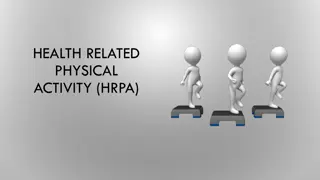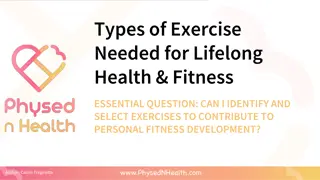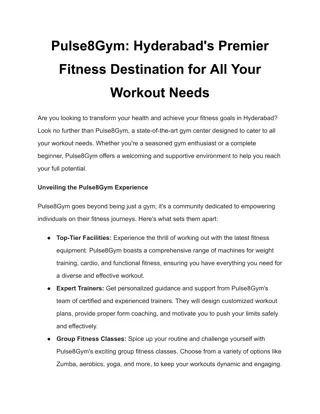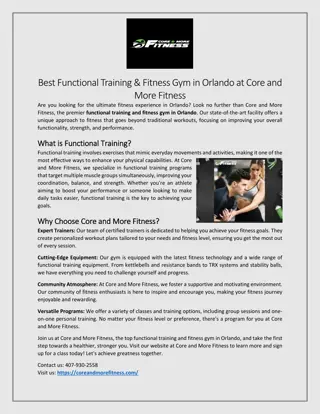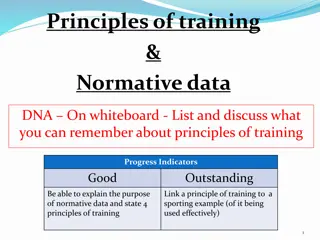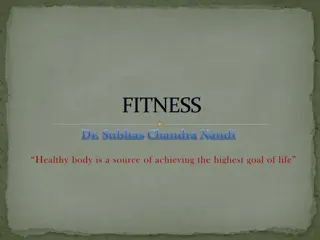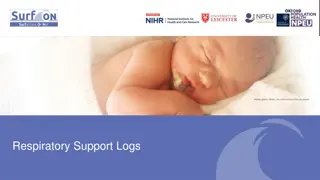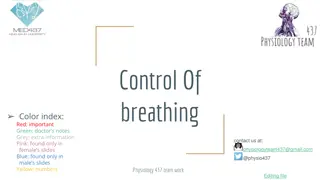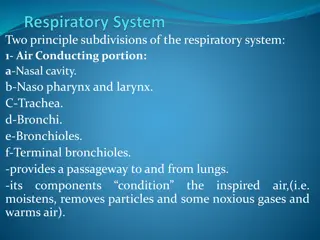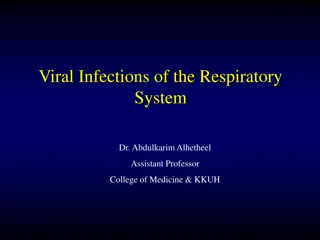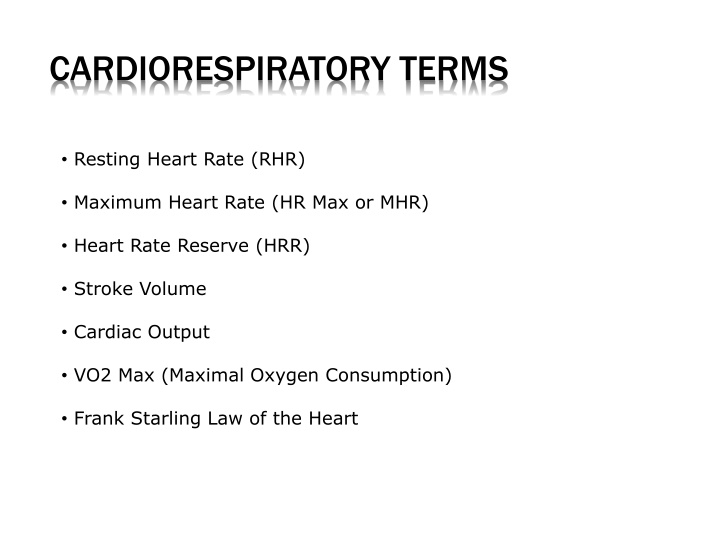
Cardiorespiratory Terms
Explore cardiorespiratory terms like Resting Heart Rate, Maximum Heart Rate, and learn about the three energy systems - Immediate, Nonoxidative, and Oxidative. Discover the benefits of cardiorespiratory endurance exercise, including improved cardiovascular functioning, reduced chronic disease risk, and better psychological well-being.
Download Presentation

Please find below an Image/Link to download the presentation.
The content on the website is provided AS IS for your information and personal use only. It may not be sold, licensed, or shared on other websites without obtaining consent from the author. If you encounter any issues during the download, it is possible that the publisher has removed the file from their server.
You are allowed to download the files provided on this website for personal or commercial use, subject to the condition that they are used lawfully. All files are the property of their respective owners.
The content on the website is provided AS IS for your information and personal use only. It may not be sold, licensed, or shared on other websites without obtaining consent from the author.
E N D
Presentation Transcript
CARDIORESPIRATORY TERMS Resting Heart Rate (RHR) Maximum Heart Rate (HR Max or MHR) Heart Rate Reserve (HRR) Stroke Volume Cardiac Output VO2 Max (Maximal Oxygen Consumption) Frank Starling Law of the Heart
ENERGY PRODUCTION ATP (adenosine triphosphate) What? Where? How? Mitochondria
THREE ENERGY SYSTEMS Immediate Energy System ATP-PCr phosphocreatine Nonoxidative (anaerobic) Energy System Lactic Acid System Anaerobic Glycolysis Oxidative (aerobic) Energy System
ENERGY SYSTEM COMPARISONS Immediate Nonoxidative Oxidative Duration of Activity 0-10 seconds 10 seconds-2 minutes 2 minutes Intensity of Activity Very high High Low Rate of ATP Production Immediate, very rapid Rapid (2 ATP per 1 molecule glucose) Slower, but prolonged (38 ATP per 1 molecule of glucose) Fuel ATP and Creatine Phosphate Glycogen and Glucose Glucose, Fat, Protein Oxygen? No (Anaerobic) No (Anaerobic) Yes (Aerobic) Limited by? Creatine Phosphate Lactic Acid Fuel sources, fatigue
CHANGES IN CARBOHYDRATE and FAT UTILIZATION DURING 90 MINUTES of AEROBIC EXERCISE.
CONTRIBUTIONS OF AEROBIC and ANAEROBIC
Benefits of Cardiorespiratory Endurance Exercise Improved Cardiorespiratory Functioning Improved Cellular Metabolism Reduced Risk of Chronic Disease Cardiovascular Diseases Cancer Type 2 Diabetes Osteoporosis Deaths from All Causes Better Control of Body Fat Improved immune Function Improved Psychological and Emotional Well-Being
BENEFITS OF CARDIORESPIRATORY EXERCISE TRAINING EFFECT 1. Improvements in Cardio-respiratory Function a. VO2 Max (maximal oxygen consumption) b. heart works less at given work load. Why? 1. stroke volume 2. cardiac output 2. rest for heart between beats (RHR) 3. oxygen carrying capacity of blood c. heart rate d. blood pressure at given work load e. increased lactate threshold
VO2 Max 1. Age Declines after age 25-30 2. Heredity Contributes 25-40% 3. Body Composition Profound effect 4. Nutritional Habits Profound effect 5. Training 20-30% increase 6. Mode of Exercise Depends on quantity of muscle mass used
EFFECT of TRAINING and BODY COMPOSITION on VO2Max Bob weighs 220 lbs or 100 kg with 20 % body fat (2.2 lbs = 1 kg) Bob s VO2 = 40 ml/kg min What effect would a 10% weight lose have on Bob s VO2 Max? 4L / 100 kg = 40 ml/kg min 4L / 90 kg = 44.4 ml/kg min Bob starts training and gains a 20% improvement. What is his VO2 Max? 44.4 X 20% = 8.88 + 44.4 = 53.3 ml/kg min
LACTATE (ANAEROBIC ) THRESHOLD WHAT? WHEN? WHY?
LACTATE (ANAEROBIC ) THRESHOLD in ENDURANCE ACTIVITIES Two male runners are competing in a 10 K race (6.2 miles) Each has a VO2 Max of 40 ml/kg min. Runner A s lactate threshold is 70% of his VO2 Runner B s lactate threshold is 85% of his VO2 All things being equal who will win? A. 40 ml/kg min X 70% = 28 ml/kg min B. 40 ml/kg min X 85% = 34 ml/kg min Winner B !!!
BENEFITS of IMPROVED CARDIORESPIRATORY FITNESS 2. Health Benefits a. Risk of Heart Disease b. blood pressure c. high density lipoprotein (HDL) cholesterol d. low density lipoprotein (LDL) cholesterol e. body fatness (easier weight control) f. risk Type 2 diabetes) g. bone density h. immune function i. long term quality of life
BENEFITS of IMPROVED CARDIORESPIRATORY FITNESS 3. Muscular adaptations a. size and number of mitochondria b. ability to use fat for energy c. size of muscle fibers being trained d. capillaries e. muscle tone and endurance
BENEFITS of IMPROVED CARDIORESPIRATORY FITNESS 4. Emotional Benefits a. anxiety and depression b. feelings of well being (self-esteem) c. work, recreational, and sport performance d. improved sleep e. easier weight control
Monitoring Your Heart Rate Carotid artery in the neck Radial artery in the wrist Count beats for 10 seconds and multiply the result by 6 to get rate in beats per minute
Components of an Exercise Prescription to Improve Cardiorespiratory Fitness Mode Frequency Intensity Duration
F.I.T.T. FORMULA FREQUENCY = INTENSITY = TIME = TYPE =
The Karvonen Formula is a mathematical formula that helps you determine your target heart rate (HR) training zone. THR= [(MHR RHR) %HRR] + RHR THR = Target Heart Rate MHR = Maximum Heart Rate (defined as 220-age) HRR = Heart Rate Reserve Example: Jane is 20 years old and has a resting heart rate of 60bpm. She wants to know her target heart rate range using 60%-80% of her heart rate reserve. THR = [(200bpm-60bpm) X 60%] + 60bpm THR= (140bpmX60% ) + 60bpm THR= 84bpm+60bpm THR = 144bpm THR = [(200bpm-60bpm) X 80%] + 60bpm THR= (140bpmX80% ) + 60bpm THR= 112bpm+60bpm THR = 172bpm Jane s THR range 144bpm to 172bpm.
Warm Up Conditioning Bout Cool Down 5-15 minutes 20-30 minutes 5-15 minutes Maximum Rate Target Heart Rate H E A R T R A T E Resting Rate
Oxygen Debt and Deficit Oxygen DEBT & Oxygen DEFICIT Oxygen Deficit Oxygen Debt (EPEOC) Steady State VO2 VO2 Untrained or people with certain cardio-respiratory diseases will have larger DEBTS and DEFICITS Rest EXERCISE TIME Onset Termination Oxygen Deficit due to: delay in time for aerobic ATP production to supply energy Oxygen Debt due to: resynthesis of PCr (creatine phosphate), ATP replace oxygen stores lactate conversion to glucose Change in HR, respiration, body temperature


